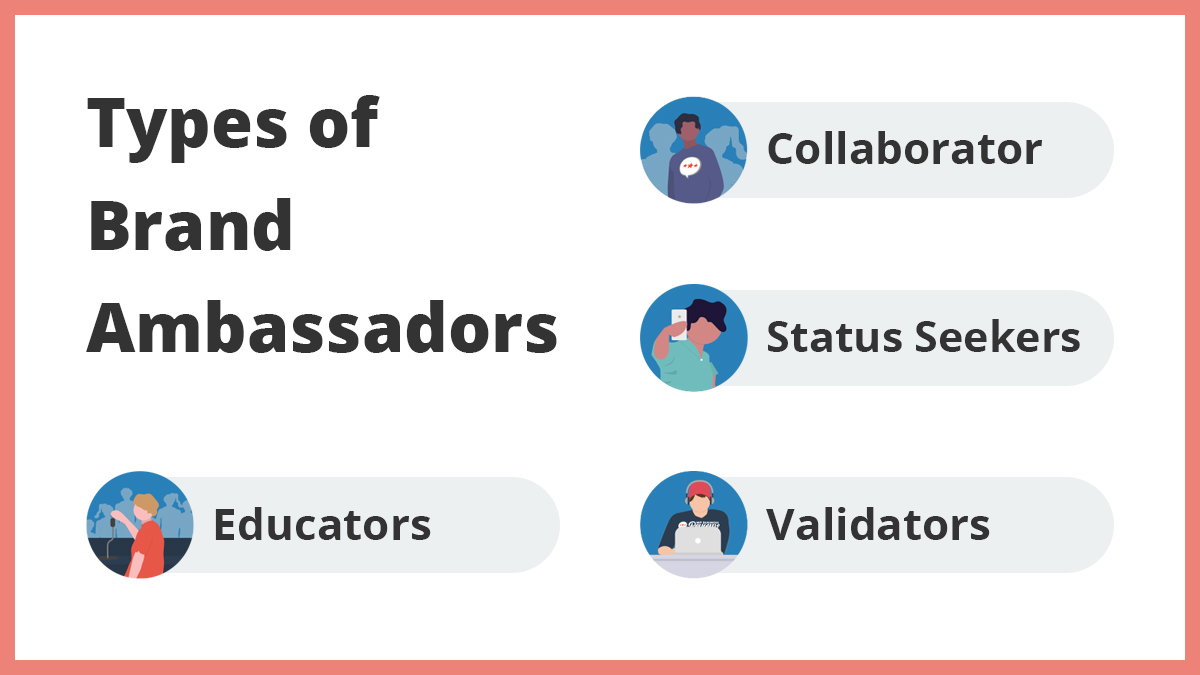It doesn’t take a lot to motivate someone to promote your brand. Here’s how you can turn the customers who leave your best reviews into brand ambassadors.
Social media favors real people over businesses, but more active and engaging individuals get even more reach and influence. It’s a game built for digital socialites. Yet businesses seem less authentic to everyday users of platforms like Facebook, Instagram, Twitter, etc.. To get around this issue, many businesses have turned to the use of “brand ambassadors.” Meaning, they use the internet’s social elite to boost their own reputation.
Many experts have recently recognized that the secret to cracking social media as a revenue stream is finding “micro-influencers” to boost your brand. That’s where brand ambassadors come into play.
What is a Brand Ambassador?
What we’re calling a Brand Ambassador has been called by many names. You might also know it by the term “evangelist,” “advocate” or even “influencer.” Although, influencer marketing is slightly different from brand advocacy. In the world of eCommerce, affiliates can also be categorized as Brand Ambassadors.
Here, we’re talking about a low-budget approach to “face-to-face” marketing that borderlines peer-to-peer sales. HubSpot defines customer advocacy as,
“[A] program that elicits customers to act as evangelists on behalf of a brand. These people have had positive experiences with the company and are excited about the opportunity to represent the brand. Customer advocacy can be displayed in a multitude of forms, including verbal references, speaking at events, posting on social media, blogging, and more.”
Essentially, businesses use people most active on social media to drive attention to their brand. This also creates an investment on the part of customers, so they’re even less likely to stray from your business. Brand Ambassadors programs are like enhanced customer loyalty programs.
Most influencer campaigns are found on Instagram. There are other platforms, but Instagram provides the highest ROI for this kind of marketing. Kurgo, a dog product company, uses brand ambassadors to gather a lot of user-generated content, like this:
Kurgo looks for anyone using their brand with high-quality photos. They run their recruitment campaign similar to a contest. This attracts “status seekers,” one kind of brand advocate. There are four main types of brand ambassadors you want to look for (Source):
- Educators: Those who love to provide information on a brand, their offerings and how best to use their products or services.
- Validators: Someone who loves to show off how great your company is and what you’ve done for them.
- Status Seekers: Those who use social media and their connections to boost their own reputation and are actively working on building a social following.
- Collaborators: Someone who might offer a complementary product, service, or opportunity to participate in small-groups or events representing your brand.
The type of Ambassador you look for is determined by your strategy. What kind of ambassadors would best represent your brand? How can you motivate them without breaking the bank? Can you inspire loyalty based on something that has no monetary value?
Creating a Brand Ambassador Strategy
The start of your “Brand Advocate” strategy needs to actually look at your customer’s goals. What does someone want to accomplish with your business? What does someone who uses your business’s products or services value? Creating customer personas is a great place to start.
“The foundation to brand advocacy is ensuring the brand itself is valuing its customers. So before shaping your strategy, you need a strong foundation of customer advocacy.
You’re already listening to customers and internalizing feedback, but ensuring this type of proactive culture is established makes advancing to brand advocacy possible.”
– Sprout Social
Before you ever consider a “Brand Advocate” strategy, make sure you have a “Customer Advocate” strategy in place. This means knowing your customers’ goals and values before you set your own.
Download the Worksheet
Our Brand Ambassador worksheet is designed to help you brainstorm before you get started strategizing. Enter your email and you'll receive a link to download.

Goals
Set two kinds of goals for your brand ambassador program: Ambassador and Brand.
Ambassador Goals tell you what your brand representatives want to get out of this. Go back to your customer concerns, values, and goals. Use the customer personas you defined earlier to identify goals your ambassadors might have. Possibilities include:
- More Followers
- Engagement with Educational Posts
- Validation Through Social Media Engagement
- A Boost to a Complementary Offering
Business Goals are those things you want to get from the program. Usually this is easy to measure using SMART goals and focuses on leads or sales.
Once you’ve identified your goals and the goals of your customers, you can move on to the rest of your strategy.
Incentives
Knowing which ambassador personality you’re working with will help you determine the necessary incentives to motivate them. You never know what someone might do for a few free stickers or a t-shirt. Others might require more to push them to publicize your brand. Some possible incentives include:
- Thank you letter
- Small gift
- Cash or discount
- Helpful content
- Exclusive or priority access to products
- Brand swag
HubSpot warns against putting too much emphasis on monetary incentives:
“While monetary rewards can be a motivator to get people in the door, they should not be the point of being an advocate. What this does is create compliant behavior when your community should really be based upon self-directed behavior – when this occurs an advocacy community truly starts to drive value
In addition, most advocacy communities, on average, have very low redemption rates (9-24%), and less success is typically seen in point-based advocacy communities.”
Essentially, find a balance. Maybe your ambassadors get a one-time discount once their “application is accepted” so that they can use your business and document the experience for the first time as an ambassador.
Workflow
Treat this program as a special project and assign someone the responsibility of project management. Create a workflow for how you will organize and communicate with your ambassadors. Know when you will measure your ROI and how you will do so. Establish your process in advance and then adjust as needed as you go along.
It’s important to make sure that your brand ambassador program is well-executed or no one will want to participate in it.
Places to Find a Potential Brand Ambassador
Now that you’ve set up your brand ambassador project, it’s time to find some recruits. The best place to start is with your best reviews. Things you will want to look for initially are:
- Review length: The more details, the better the potential for a brand ambassador.
- Number of reviews: You can usually see how many reviews each reviewer has left overall on the platform. The number of reviews might be tiny, but if they are all lengthy and well-thought out reviews, then the person may be a good candidate. If they leave tons of 5-star reviews with minimal content, they may not be the best potential ambassador.
- Profile: Look at the other details of their profile on the platform you’re looking at. If it’s Yelp or Google, you can see more about the details they leave in their reviews and a few other insights.
Once you’ve established your top reviewers, you can do one of two things. Either send them an invitation to apply for your brand ambassador program or investigate further. Investigating more will take more of your time than if you ask them to send you the information themselves. The first thing you will want to know is how they use your product or service and how often. Other information you might want to investigate is:
- Facebook: Ask for a link to their profile. Find out how often they post, how many friends they have, and if they get a lot of engagement on their page.
- Instagram: As the platform with the best ROI, this one is important. Ask the same questions as you would for Facebook.
- Twitter: If a lot of your target audience is active on Twitter, find out their number of followers, engagement rates, etc. here as well.
- YouTube: Find out if they are on YouTube and if so, how many subscribers do they have? How active is their channel?
- Events: Do they participate in any events related to or hosted by your business?
- MailChimp / Email List Scores: Are they subscribed to your email list and how much do they engage with your content?
You can even take it a step further and use a social network analysis tool to do the work for you. Once you’ve found a few potential ambassadors with the right analytics, make sure they will represent your brand well, too.
Choosing the Right Brand Ambassador
Someone might have all the followers in the world and 50 comments on every post. Their influencer score might be off the charts, but if they don’t match your brand then it won’t help you to recruit them. That’s why you need access to their social media profiles prior to selecting them as an ambassador. You might even ask them to write a paragraph explaining why they want to be your brand ambassador.
The most important thing to keep in mind is your own brand tone and voice. If you don’t have that established, go back to your strategy planning. Write out your brand message, tone, voice, and overall emotions associated with your brand.. Anything to put your brand in context for your ambassadors helps.
Key Things to Avoid in a Brand Ambassador
Always avoid trolls. No matter what, avoid the person who has high engagement on their page because they’re surfing the internet for snarky comments to make. There’s no point in choosing a fire-starter, unless that matches your business in some way. There’s a restaurant called “Dick’s Last Resort” that might be the perfect example of an exception to this rule and any of the others listed here.
The next thing to look out for are overly political or controversial posts. If your business thrives on both sides of the political line, then you might want someone who also stays in the middle. However, there are caveats to this, too. A gun store might like the idea of a right-wing conservative representing his brand with their outspoken gun policy posts. On the other hand, a nature preservation might lean on a left-wing liberal who makes sure their voice is heard in the fight for environmental policy.
Finally, be on the lookout for foul language and overall vocabulary. Profanity might work for a large number of businesses but if it doesn’t match your brand, avoid it. Similarly, their vocabulary or grammar might turn out to be terrible. If that’s the case, you might also consider how it would reflect on your brand.
Recruiting Your Army of Ambassadors
Whether it’s an army of one or an army of tons, you need to figure out how you will recruit and choose your ambassadors. We recommend hand selecting your first round of recruits, but as you scale, your process might need to get more streamlined. Remember to keep the ambassador personas in mind as you select your team.

We already showed you Kurgo’s Spring drive, where they announced their “ambassador recruitment drive” in a contest format. There are also apps you can engage for your business where people sign up to be brand ambassadors for the brands they love. This might produce less loyal ambassadors, but you might find a larger number of applicants.
Keeping Your Ambassadors Engaged
Retention rates for ambassadors depend on the quality of your program. If you find you’re losing a lot of ambassadors, dig into the reason. Go back to your first goal in your strategy: What does your ambassador want out of the program? If needed, implement an exit survey.
To keep ambassadors engaged from the beginning make sure they aren’t motivated for the wrong reasons. Create a program that gives them priority access to your products, occasional discounts, and exclusive content. You might even implement a tiered program where ambassadors recruit their friends to join, too . Just make sure you’re communicating with your ambassadors.
Measuring the Return on Interest of a Brand Ambassador
It’s great to build up an online reputation with an army of ambassadors. But if there is no direct translation to your revenue then it’s a waste of time. So, plan ahead. Figure out how you will track the return on your ambassadors before you start. Many programs use codes or affiliate links to directly track sales associated with each ambassador.
Most of what you get from a brand ambassador are things that aren’t easy to quantify. Things like:
- Engagement
- Social Reach
- Content Quality
These are also important measurements and shouldn’t be overlooked. Even if an ambassador’s link or code isn’t being used, they may provide other returns on your investment.
Get Started – Create Your Brand Ambassador Strategy
Create your strategy and let us know how it goes. If you’ve already implemented a brand ambassador program, tell us more about it in the comments!


[…] and center in the minds of millions of people, but it also shows the power of using tools like brand ambassadors and influencers for […]